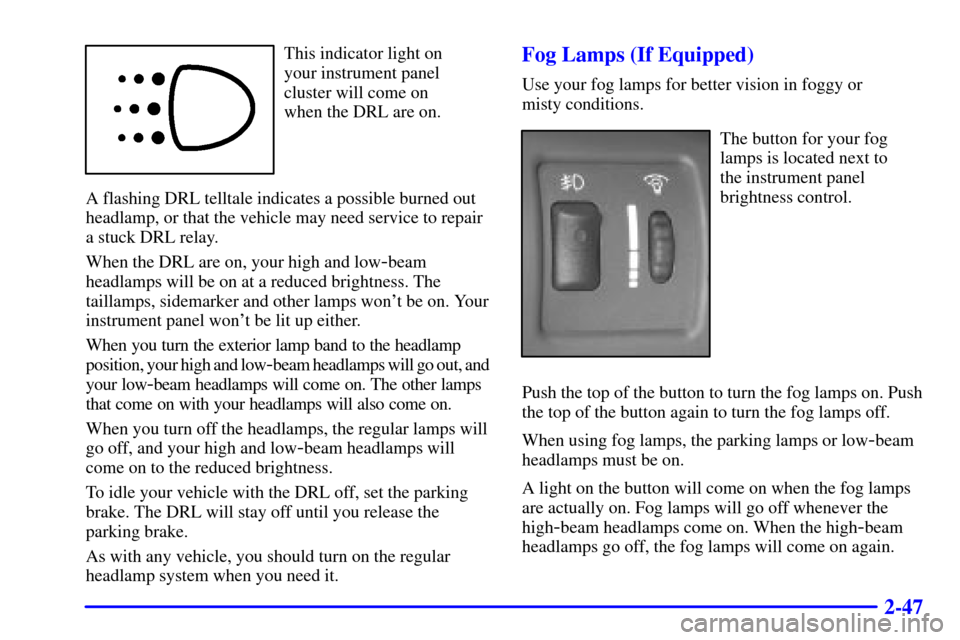Page 108 of 360

2-47
This indicator light on
your instrument panel
cluster will come on
when the DRL are on.
A flashing DRL telltale indicates a possible burned out
headlamp, or that the vehicle may need service to repair
a stuck DRL relay.
When the DRL are on, your high and low
-beam
headlamps will be on at a reduced brightness. The
taillamps, sidemarker and other lamps won't be on. Your
instrument panel won't be lit up either.
When you turn the exterior lamp band to the headlamp
position, your high and low
-beam headlamps will go out, and
your low
-beam headlamps will come on. The other lamps
that come on with your headlamps will also come on.
When you turn off the headlamps, the regular lamps will
go off, and your high and low
-beam headlamps will
come on to the reduced brightness.
To idle your vehicle with the DRL off, set the parking
brake. The DRL will stay off until you release the
parking brake.
As with any vehicle, you should turn on the regular
headlamp system when you need it.
Fog Lamps (If Equipped)
Use your fog lamps for better vision in foggy or
misty conditions.
The button for your fog
lamps is located next to
the instrument panel
brightness control.
Push the top of the button to turn the fog lamps on. Push
the top of the button again to turn the fog lamps off.
When using fog lamps, the parking lamps or low
-beam
headlamps must be on.
A light on the button will come on when the fog lamps
are actually on. Fog lamps will go off whenever the
high
-beam headlamps come on. When the high-beam
headlamps go off, the fog lamps will come on again.
Page 118 of 360
2-57
The main components of your instrument panel are the following:
A. Fog Lamp Button (If Equipped)
B. Instrument Panel Brightness Control
C. Turn Signal/Multifunction Lever
D. Instrument Panel Cluster
E. Hazard Warning Flashers Switch
F. Ignition Switch
G. Windshield Wiper/Washer Controls
H. Cigarette Lighter (If Equipped)
I. Audio SystemJ. Climate Controls and Rear Window Defogger
K. Fuse Panel
L. Remote Trunk Release Button
M. Hood Release Lever
N. Tilt Steering Wheel Lever (If Equipped)
O. Parking Brake Lever
P. Accessory Power Outlet
Q. Shift Lever
Page 138 of 360

3-3
(Maximum): For maximum cooling use this setting
to recirculate much of the air inside your vehicle and
send it through the instrument panel outlets. The air
conditioning compressor will run automatically in this
setting when it is needed to help cool the air in the
vehicle. Operation in this mode during periods of high
humidity and cool outside temperatures may result in
increased window fogging. If window fogging is
experienced, select the defrost mode.
(Vent): This setting brings in outside air and directs
it through the instrument panel outlets.
(Bi-Level): This setting brings in outside air
and directs it two ways. Some air is directed through
the instrument panel outlets. Most of the air is directed
through the floor ducts and a little to the defrost and
side window vents.
(Floor): This setting sends most of the air
through the ducts near the floor. The rest comes out
of the defroster and side window vents.
(Defog): This setting allows half of the air to go
to the floor ducts and half to the defroster and side
window vents.
(Defrost): This setting directs most of the air
through the defroster and side window vents. Some of
the air goes to the floor ducts. The air conditioning
compressor will run automatically in this setting when
it is needed to help dry the air in the vehicle. The A/C
indicator light will also be on in the setting.
Air Conditioning Compressor Button
Press the A/C button to operate the air conditioner
compressor. The indicator light above the button will
glow when the air conditioning compressor is running.
You don't have to press the button to run the compressor
in maximum or defrost.
It is normal for the A/C indicator light to come on while
in defrost.
Running the compressor will help reduce vehicle
interior fogging.
Page 139 of 360

3-4 Air Conditioning
On very hot days, open the windows long enough to
let hot, inside air escape. This reduces the time it takes
for your vehicle to cool down, which should help
fuel economy.
For quick cool
-down on very hot days, use the
maximum mode setting with the temperature knob
all the way in the blue area. If this setting is used for
long periods of time, the air in your vehicle may become
too dry. The best cool
-down happens if you start in
one of the other modes and then switch to maximum.
For normal cooling on hot days, use vent with the
temperature knob in the blue area and the A/C button
pressed in. The system will bring in outside air and cool it.
On cool, but sunny days, the sun may warm your upper
body, but your lower body may not be warm enough.
You can use bi
-level with the temperature knob in the
middle and the A/C button pressed in. The system will
bring in outside air and direct slightly warmer air to
your lower body. You may notice this temperature
difference more at some times than others.
Heating
On cold days, use floor with the temperature knob all
the way in the red area. The system will bring in outside
air, heat it and send it to the floor ducts.
Your vehicle has heat ducts that are directed toward
the rear seat. Keep the area under the front seats clear
of obstructions so the heated air can reach the rear
seat passengers.
If your vehicle has an engine coolant heater, you can use
it to help your system provide warm air faster when it's
cold outside (0�F (
-18�C) or lower). An engine coolant
heater warms the coolant your engine and heating
system use to provide heat. See ªEngine Coolant
Heaterº in the Index.
Defogging and Defrosting
Your system has two settings for clearing the front
and side windows. To defrost the windows quickly,
use defrost with the temperature knob all the way
in the red area. To warm passengers while keeping the
windows clean, use defog.